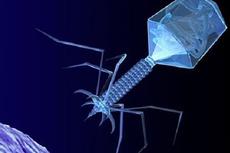来源:农环视界
原标题:Chemical Engineering Journal: 生物炭吸附铜强化催化过硫酸钠降解四环素
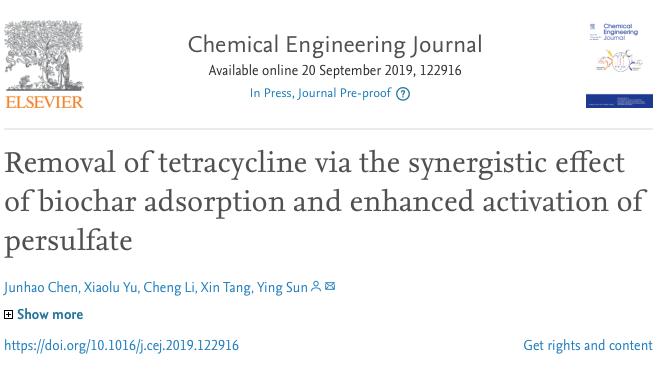
近日,国际TOP学术期刊Chemical Engineering Journal 在线发表了中国农业大学孙英教授课题组的最新研究成果“Removalof tetracycline via the synergistic effect of biochar adsorption andenhanced activation of persulfate”。针对目前养殖业废水无害化技术的空缺,以及养殖业废水中Cu、Zn等重金属和各类兽用抗生素同时共存的现状,本研究在铜离子和四环素同时存在的条件下加入生物炭和过硫酸钠,在生物炭表面Cu(II)被吸附并被还原成对过硫酸钠催化能力更强的Cu(I),从而提高了体系对四环素的去除效率。基于反应动力学和界面反应表征,揭示了生物炭在高级氧化技术应用中起到稳定催化剂,提高催化剂活性的作用,建立了一种原位催化过硫酸盐去除养殖废水中重金属及抗生素的新方法,为金属和抗生素复合污染的去除提供技术和理论基础。
近年来畜禽养殖业的快速发展,产生大量养殖废水包括畜禽粪尿和发酵沼液。养殖废水中含有丰富的氮、磷、钾等营养元素,具有广阔的农业资源化利用前景。但是粪尿与沼液等养殖废水直接施用存在抗生素和重金属的传播风险,阻碍了资源化利用。因此如何有效地处理养殖废水中重金属及抗生素复合污染是养殖废水资源化利用亟待解决的难题。
本研究通过考察不同温度条件制备的生物炭和不同去除体系对四环素的去除效率,确定在700℃下制备的生物炭和铜离子以及过硫酸钠体系(Cu/BC700/PS)对四环素去除效率最高。SEM、EDS、XRD、EPR、XPS等表征结果表明生物炭上铜可以Cu(I)的形式稳定存在,且在反应前后没有出现其他价态的Cu,揭示生物炭在Cu(I)催化过硫酸钠过程中为Cu(I)持续提供电子,维持Cu(I)的催化活性。
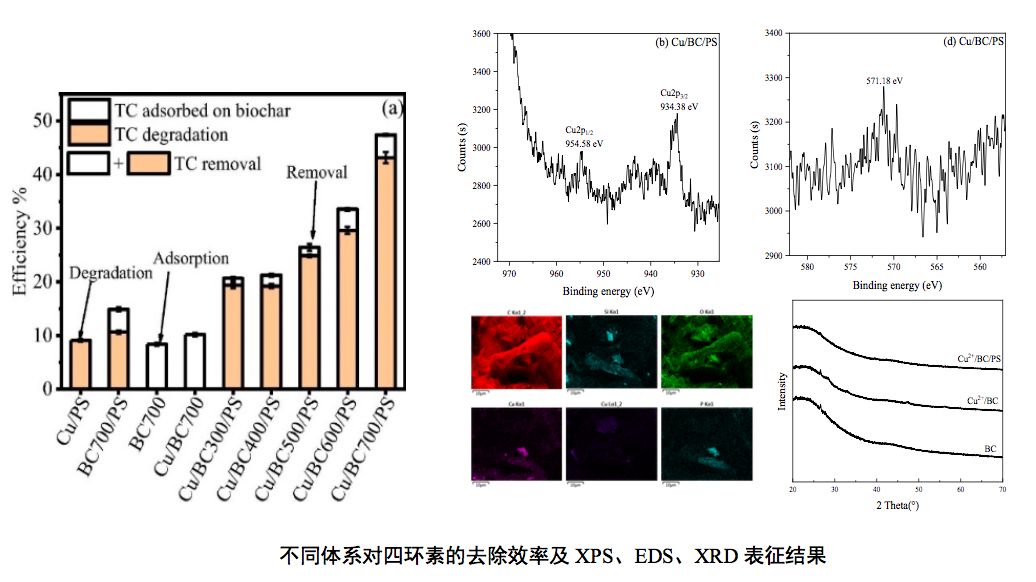
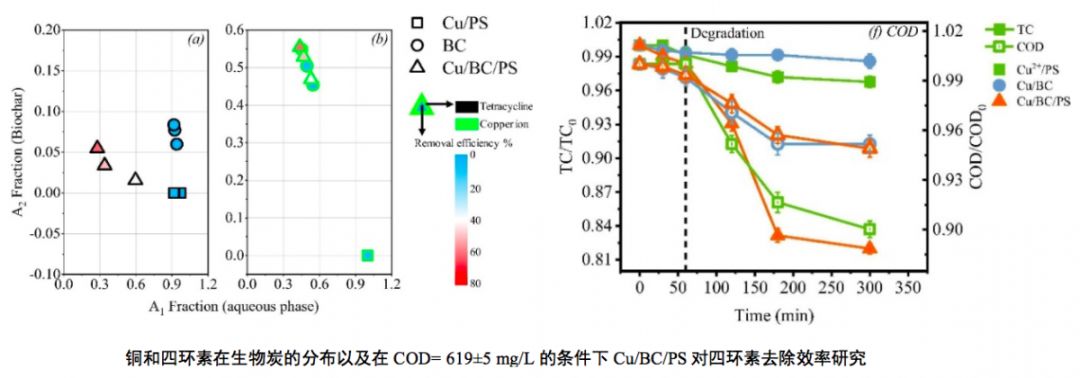
在水处理的高级氧化技术中,废水的高浓度COD往往是制约其高效利用的主要因素。而在本研究的Cu/BC/PS体系中,由于生物炭对体系中铜离子和四环素的吸附富集,活化催化反应主要集中在生物炭表面进行,一定程度上减弱了COD对过硫酸钠的竞争,因此,即使在COD=619±5mg/L的条件下,Cu/BC/PS体系对四环素的去除效率比Cu/PS体系和Cu/BC体系高约6倍和13倍,这对于今后采用该技术原位同时去除养殖废水中的重金属和抗生素提供了重要的理论基础。
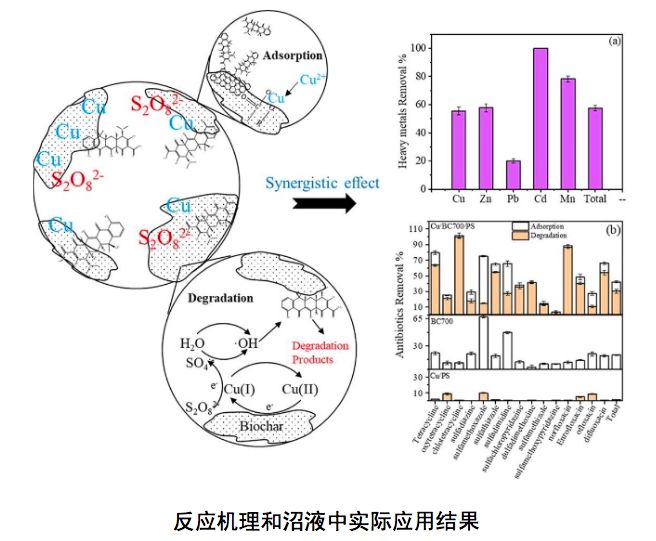
在实际应用中,在1L沼液中投加0.6g/L过硫酸钠和1g/L生物炭对四环素、磺胺、喹诺酮三大类15种抗生素的平均去除率可达42.7%,其中,对四环素、金霉素、诺氟沙星的去除率超过80%,5种重金属(Cu、Zn、Pb、Cd、Mn)平均去除率可达54.8%,其中Cd、Mn去除率超过80%。本研究建立了一种利用生物炭为载体作为催化助剂,以吸附的重金属作为催化位点强化催化过硫酸盐去除抗生素的新方法,该方法简单易行,成本低,可实现原位同步去除养殖废水中重金属和抗生素,对于保障养殖废水农田安全利用具有重要意义。
中国农业大学资源与环境学院的博士研究生陈俊豪为该论文的第一作者,孙英教授为论文的通讯作者。该研究得到了国家重点研发计划项目的资助。
英文摘要: Wedeveloped a simple in-situ system to remove model antibiotictetracycline (TC) using biochar (BC) adsorption and persulfate (PS)oxidation (Cu/BC/PS). The biochar produced by pyrolysis of cornstalks at 700 °C exhibited a much higher Brunauer-Emmett-Teller(BET) surface area (431 m2/g),absorption capacity of Cu2+(8.37 mg/g) and tetracycline (18.80 mg/g) than that of othertemperature-prepared biochar. The removal efficiency of TC with theCu/BC700/PS system reached 55.4%-72.6% with solution conditions of pH4-9, 120 mg/L TC, 300 mg/L PS and 0.5 g/L BC. Under 619±5 mg/Lchemical oxygen demand (COD) condition, the TC removal efficiency ofthe Cu/BC700/PS system was about 5 times more than that of the Cu/PSsystem. The results of characterization methods such as Electronparamagnetic resonance (EPR), X-ray photoelectron spectroscopy (XPS),and radical quenching experiments suggested that the reduced Cu(I) onbiochar was a catalytic center in the degradation process and theSO4·-and·OH were the dominant radicals. The reaction kinetics showed thatthe BC adsorption of Cu2+and TC were the limiting steps of the entire reaction. A proposedsystem mechanism is that Cu is absorbed by the biochar and helpsfurther enhance the activation of PS. In the practical application tobiogas slurry (2383±47 mg/L COD), the total removal efficiencies of5 heavy metals and 15 antibiotics were 57.4% and 42.3%, respectively.Moreover, the germination index (GI) of the biogas slurry increasedfrom 8.50% to 43.48% after treatment. Thus, the Cu/BC/PS system has agreat prospect in the harmless treatment and recycling of livestockwastewater.
论文链接:
https://doi.org/10.1016/j.cej.2019.122916
来源:nhsj-wx 农环视界
原文链接:http://mp.weixin.qq.com/s?__biz=MzU1NzM0MjI1NQ==&mid=2247487043&idx=1&sn=0b8cb750595095b084e664b9c2cd7df2&chksm=fc360503cb418c15f28b55acde0ea8fe02fb12cff1379123f3911ea5e45cff1d15d41ce3fc78&scene=27#wechat_redirect
版权声明:除非特别注明,本站所载内容来源于互联网、微信公众号等公开渠道,不代表本站观点,仅供参考、交流、公益传播之目的。转载的稿件版权归原作者或机构所有,如有侵权,请联系删除。
电话:(010)86409582
邮箱:kejie@scimall.org.cn

